 7.5x54mm MAS
7.5x54mm MAS 7.5x54mm MAS
7.5x54mm MASA modern centerfire cartridge after 35 years of searching.
The 7.5x54mm Mle 1929 C would become the French service rifle cartridge for fifty years.
| Article by Steve N. Jackson (v. 1) |
Designing the Round
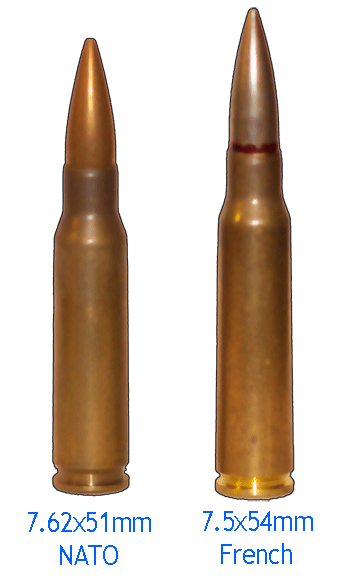 Prior to the Great War the French experimented with nearly a dozen innovative, rimless, high-powered, smokeless powder cartridges, finally settling on the 7x57mm Meunier round pushing a 9 gram lead-core copper-jacketed bullet at 850 meters per second. The Meunier rifle and carbine system it was designed were just a few years from service when development was slowed. A new and expensive rifle, which would have been embraced just a decade before, did not meet the new French Army emphasis on courage over technology. Fewer than 6,000 of the weapons were issued by the start of 1914 and the proper tactics to use them had not been explored.
Prior to the Great War the French experimented with nearly a dozen innovative, rimless, high-powered, smokeless powder cartridges, finally settling on the 7x57mm Meunier round pushing a 9 gram lead-core copper-jacketed bullet at 850 meters per second. The Meunier rifle and carbine system it was designed were just a few years from service when development was slowed. A new and expensive rifle, which would have been embraced just a decade before, did not meet the new French Army emphasis on courage over technology. Fewer than 6,000 of the weapons were issued by the start of 1914 and the proper tactics to use them had not been explored.
The Great War was to prove how forward thinking the Meunier design was, and how important switching to a modern rimless cartridge was for the French military establishment. When it is remembered that the 8x50Rmm was never intended to be anything but an interim cartridge to take advantage of conversions from the older 11mm Gras the problem with the older "Lebel" round is magnified. Although many authors have offered reasons why the 8mm was obsolete from case design preventing use in automatic weapons to simple ugliness, in fact the round was no more obsolete than the British .303 or the Russian 7.62x54mm Nagant, both rimmed rounds that took special care to design automatic weapons around. Machine guns in fact could easily be designed to use all three technically obsolete rounds. The main goal of seeking a new ammunition type was to return to the pre-war idea of creating a one or two design universal rifle system, and the thick base of the 8x50 simple made double column magazines too thick for practical use, while single column magazines curved awkwardly when designed to handle more than five rounds.
In 1920 French engineers took all of the cartridges that the French Army, its allies, or its enemies had used during the Great War and started to seriously look at a cartridge that could serve as a machine gun round, an infantry rifle round, and as a carbine round. The French had perhaps the best position of any combatant to experiment with new small arms ammunition. Before the war their arms industry was second only to the United States in manufacturing capacity, while their arms design organizations were the envy of the western world. They also had unparalleled access to the world's greatest centers of arms manufacture. Both Deutsche Waffen und Munitionsfabriken Aktien-Gesellschaft and Krupp were occupied at times by French soldiers after the war, while French engineers had worked in American arms plants including Savage, Colt, Remington, and the United States armory at Springfield both to assure French arms and ammunitions met French standards. The French data set was impressive.
The French had seen during the Great War the American 7.62x63mm (U.S. cal. .30 M1 chambered in M1903 and M1917 rifles), the 7x57mm Mauser used by the Brazilian observation forces (chambered in the M1908 rifle), the 8x57mm Mauser carried by the German Army, the 7.5x55mm Swiss of the Swiss Army, and the Swedish 6.5x55mm Mauser. In addition nearly twenty experimental rounds existed in the French testing establishment, including rounds that had actually seen service like the 7mm Meunier. Thus they knew the the round they wanted would shoot a 7.5mm round of around 10 grams at greater than 800 meters per second. The round had to be effective in rifles, portable machine guns, heavy machines guns, and carbine length rifles then being contemplated, and had to not have such heavy blast or recoil as to be unusable by foreign troops who were often of smaller stature than Europeans. The round had to be rimless, and would use standard Army powder and primer compositions. The Army preferred that the round be brass, but would entertain steel-cased rounds if they proved to be cheaper without damaging the actions of the weapons they were fed through.
Most of these rounds were tested extensively in French armories in 1919, and in 1920 a top-secret shoot-off was was held to determine which ammunition best met the French needs for a service ammunition. As a result of these tests an experimental round was fielded in 1921, the X10 7.5x56mm. Minor improvements were made in the round until an improved version was standardized in as the Mle 1924c in 1924 and chambered for the MAC FM Mle 1924 machine gun.
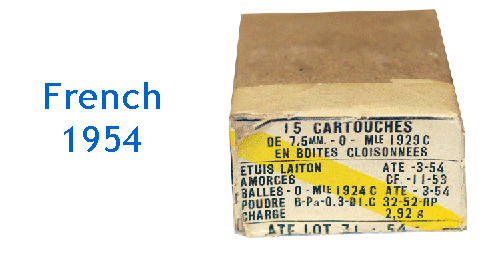 The 7.5x58mm Mle 1924c was a marriage of a lengthened 6.5x55mm Mauser casing with a the bullet design that closely resembles a commercially loaded 7.62x63mm round, then standard in the United States Army. It was noted in use that the 7.5x58mm was extremely accurate, and provided good velocity over the entire flight path it could be expected to be used. It functioned flawlessly in MAC FM Mle 1924 machine gun, and early chamberings of repeating rifles for it were promising. The use of a 9-gram boat-tail bullet in the Mle 1924c even caused the United States military to redesign their own service round as a response, resulting in the .30 M2.
The 7.5x58mm Mle 1924c was a marriage of a lengthened 6.5x55mm Mauser casing with a the bullet design that closely resembles a commercially loaded 7.62x63mm round, then standard in the United States Army. It was noted in use that the 7.5x58mm was extremely accurate, and provided good velocity over the entire flight path it could be expected to be used. It functioned flawlessly in MAC FM Mle 1924 machine gun, and early chamberings of repeating rifles for it were promising. The use of a 9-gram boat-tail bullet in the Mle 1924c even caused the United States military to redesign their own service round as a response, resulting in the .30 M2.
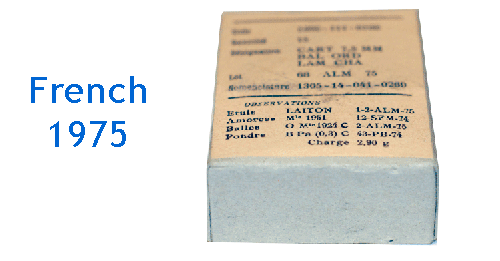 One disadvantage of the 1924c that came to light was that machine guns chambered for it could also chamber the 8x57mm Mauser, but the larger 7.9mm bullet of the Mauser round would lodge in or destroy a 7.5mm barrel when fired. After the Great War the French inherited a large number of German machine guns, most firing the 8x57mm IS round so the similarity of the rounds was not just theoretical, French soldiers often had to account for both 7.5x58mm and 8x57mm ammunition.
One disadvantage of the 1924c that came to light was that machine guns chambered for it could also chamber the 8x57mm Mauser, but the larger 7.9mm bullet of the Mauser round would lodge in or destroy a 7.5mm barrel when fired. After the Great War the French inherited a large number of German machine guns, most firing the 8x57mm IS round so the similarity of the rounds was not just theoretical, French soldiers often had to account for both 7.5x58mm and 8x57mm ammunition.
Safety measures such as issuing different weapons to different divisions, prominent marking of bullets and ammunition cases, and requests that officers measure bullets before they were issued to troops did not solve the issue. Dozens and perhaps hundreds of incidents occurred where Mauser ammunition caused accidents shook troop morale and made the French ordinance authorities take drastic action. The French military establishment called in all MAC FM Mle. 1924 machine guns and re-barreled them for a new round, designated the 7.5x54mm Mle 1929c - which was identical to the older Mle. 1924c ammunition except for a case that was 4mm shorter, making it impossible to chamber 8x57mm ammunition in those weapons.
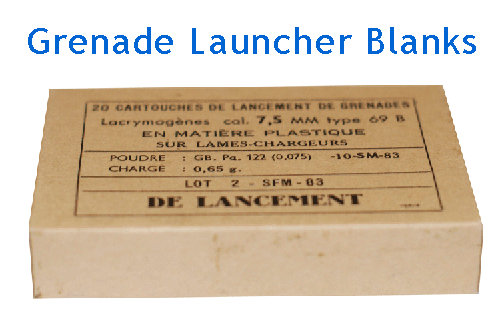
The 7.5x54mm round turned out to be very successful. Its shorter length meant that repeating rifles and semi-automatic rifles chambered for it could have shorter bolt throws, which meant lighter weapons and faster lock-up time. In this the 7.5x54mm predicted the best qualities of the 7.62x51mm 25 years before it was developed. The weapon still retained the power of its likely adversary, the 8x57mm, and was suitable for adoption in aircraft and tank guns. It also retained the accuracy of its larger sibling, meaning that the French practice of having trained marksman deployed at the section level did not require a separate weapon system. Indeed the development of the new semi-automatic rifle to use the 7.5x54mm assumed that each rifle would at least be capable of taking on this role as well as launching grenades, two key elements of French strategy.
The French would eventually carry forward a two-weapon strategy that had been planned prior to the Great War, both firing the same cartridge, with a submachine gun backing up these two weapons. The two new rifles would arrive as the MAS Mle 1936, intended for support troops, and the MAS Mle 1940 for front-line soldiers. The Mle 1936 would appear in time for World War Two, but the Mle 1940 would have to wait until after the war, when it was adopted as the Mle 1944.
The 7.5 French was proposed for phase out six times from the French military.
1) In 1947 it was proposed to replace the 7.5x54mm with the 7.62x33mm (.30 U.S. Carbine) round. This was found to be unfeasible due to lower stopping power of the 7.62x33mm interfering with its use as a sniper round, although carbines would be used by the French Army until the 1960s. Several efforts were made to produce a 7.62x33mm lightweight battle rifle during the early 1950s, and experience with carbines in Asia proved the worth of the ammunition, but eventually efforts to introduce a general purpose rifle firing the carbine round stopped.
2) The 7.92x33mm round was likewise considered in 1947 and had serious support, including the adoption of a rifle that was the prototype for the later German G3. This idea was discarded when the .280 British and the FAL rifle became the most important contender for a NATO standard rifle. 7.62x39mm rounds were never used except experimentally by the French army, and never saw front-line service.
3) In 1948 there was brief consideration of converting the French Army to the .276 Petersen or .280 British round as part of a radical overhaul of the entire North Atlantic defence standardization, which would include a common service rifle. This proved politically impossible and financially difficult, and was soon dropped.
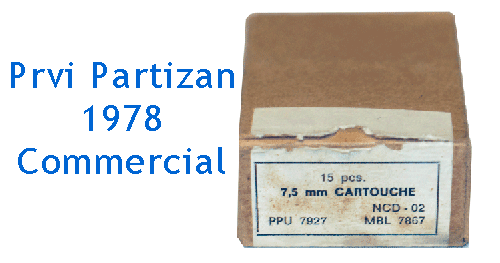 4) In 1949 plans existed to convert to the 7.62x63mm round due to the huge number of weapons then chambering that ammunition in service, and since the French had accumulated war stocks of 300 or more fighting days for its Army. The plans went as far as chambering a version of the MAS Mle 1949 semi-automatic rifle for this round. This plan was put on hold and finally dropped when it became clear that the United States Army was moving away from the 7.62x63mm in favor of a new NATO standard round (the 7.62x51mm).
4) In 1949 plans existed to convert to the 7.62x63mm round due to the huge number of weapons then chambering that ammunition in service, and since the French had accumulated war stocks of 300 or more fighting days for its Army. The plans went as far as chambering a version of the MAS Mle 1949 semi-automatic rifle for this round. This plan was put on hold and finally dropped when it became clear that the United States Army was moving away from the 7.62x63mm in favor of a new NATO standard round (the 7.62x51mm).
5) in 1953 it was proposed to adopt the new NATO round then in development as the standard French military round. This idea had serious adherents in the French military establishment, but was shelved when it became obvious that the earliest that most NATO countries would have rifle in place that fired this round was 1960 (it turned out the earliest NATO calibre rifle was the FAL, put into mass production in 1958, and the Garand derived Italian BM59, completed the next year). As it was the French standard battle rifle was expected to be available before 1957 if it used the original 7.5x54mm round. This weapon turned out to be the MAS Mle 1949/56. Pressure to adopt the 7.62x51mm continued until the 1970s and would result in the re-chambering of French machine guns and sniper rifles for it after the adoption of the 5.56x54mm for standard infantry use.
6) In the early 1960s it was proposed to adopt the new 5.56x54mm for use by all French forces. This would be actually carried out, resulting in the withdrawal from service of the 7.5x54mm chambered weapons from 1975 to 1985.
The 7.5x54mm survived in French service for more than 50 years, making it a successful round, although it was used only sporadically by other countries when they received shipments of French weapons.
Commercial Use
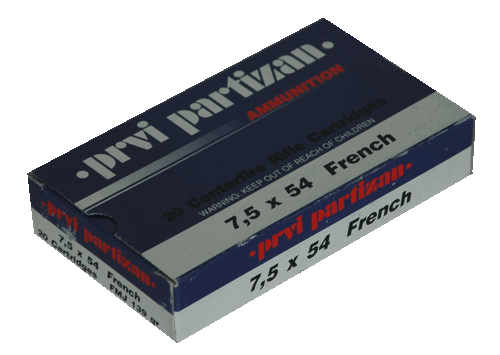 French laws prohibit the chambering of commercial hunting weapons for "military" calibres, placing these weapons in a category that can be difficult to own, so the commercial ammunition industry has never explored the 7.5x54mm. Its similarity to 7.62x51mm means that no commercially made rifles are chambered for it despite its ease of reloading. Ammunition though has been sporadically available if you know where to look.
French laws prohibit the chambering of commercial hunting weapons for "military" calibres, placing these weapons in a category that can be difficult to own, so the commercial ammunition industry has never explored the 7.5x54mm. Its similarity to 7.62x51mm means that no commercially made rifles are chambered for it despite its ease of reloading. Ammunition though has been sporadically available if you know where to look.
The ideal place is French surplus ammunition. Millions of surplus rounds have been imported in recent years, and they can be purchased at around 7.00 $USD per box of 20 through commercial vendors. These rounds are mildly corrosive, but tend to be reliable as long as they are from the 1960s and 1970s. Some ammunition from other countries, such as Syrian surplus, is not reliable and should be avoided.. It should be remembered that it is difficult to reload military ammunition from Europe as it is usually capped with Berdan primers, so your costs on these rounds should rarely go above half the price of commercial ammunition, as you will never be able to reload it again.
New commercial ammunition is loaded by the Serbian ammunition company Prvi Partizan and by Precision Cartridges. Both ammunition sources have variable availability. Precision Cartridges ammunition is often loaded with soft nose hunting bullets and is high quality ammunition. At $25.00 per box though it is more expensive than most other military ammunition, although well in line with commercial loadings of civilian hunting ammunition. Prvi Partizan ammunition is also available in sporadic doses. When available the ammunition is of good quality, with only one style usually offered (the full metal jacket, which functions best in the MAS 49 series autoloader). The usual cost of this ammunition is around $16.00 a box, making it similar in price to other 7mm range military ammunition.
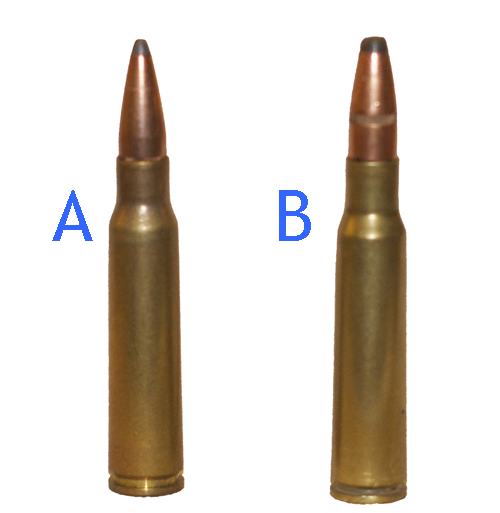 Contrary to popular belief commercial 7.5x54mm hunting ammunition has occasionally reached the market, usually produced by commercial re-loaders. Two examples are the 1990's era loading for 10.7 gram jacketed soft points (A). This machine loaded ammunition was made from surplus supplies by Ed Wyman and was considered of very high quality with tens of thousands of rounds being sold for nearly ten years. It left the market after May of 2009 when Mr. Wyman's storage facility exploded, garnering the small businessman an $800,000 fine and a 5-year prison sentence. The ammunition was also available in the 1950s and 1960s when Golden State Arms produced 10.8 gram soft nose bullets (B) especially for its Santa Fe model 1949 sporter, a cut down MAS MLE 1936 rifle. Golden State also imported newly loaded military ammunition from France which, when found on the market today, is nearly identical to regular military ammunition even though it was purchased outside the regular ammunition supply chains.
Contrary to popular belief commercial 7.5x54mm hunting ammunition has occasionally reached the market, usually produced by commercial re-loaders. Two examples are the 1990's era loading for 10.7 gram jacketed soft points (A). This machine loaded ammunition was made from surplus supplies by Ed Wyman and was considered of very high quality with tens of thousands of rounds being sold for nearly ten years. It left the market after May of 2009 when Mr. Wyman's storage facility exploded, garnering the small businessman an $800,000 fine and a 5-year prison sentence. The ammunition was also available in the 1950s and 1960s when Golden State Arms produced 10.8 gram soft nose bullets (B) especially for its Santa Fe model 1949 sporter, a cut down MAS MLE 1936 rifle. Golden State also imported newly loaded military ammunition from France which, when found on the market today, is nearly identical to regular military ammunition even though it was purchased outside the regular ammunition supply chains.
Cartouche de 7.5 Mle 1929 C
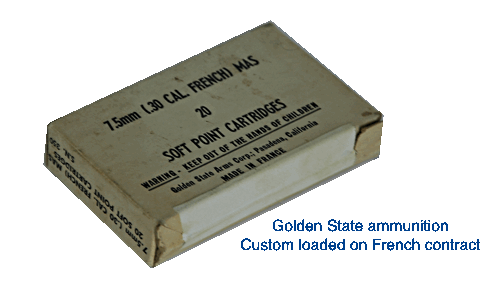 The standard military 7.5x54mm round was produced by the French army from 1929 to 1979. The ammunition was packed in 15 and 25 round boxes, and 50 round belts. Modern commercial ammunition is usually sold in 20 round boxes.
The standard military 7.5x54mm round was produced by the French army from 1929 to 1979. The ammunition was packed in 15 and 25 round boxes, and 50 round belts. Modern commercial ammunition is usually sold in 20 round boxes.
| 7.5x54mm | |
| Bullet Diameter | 7.8mm |
| Rim Diameter | 12.2mm |
| Case Length | 54mm |
| Bullet Weight | 9gr |
| Muzzle Velocity | 823m/s |
| Muzzle Energy | 3,028 J |